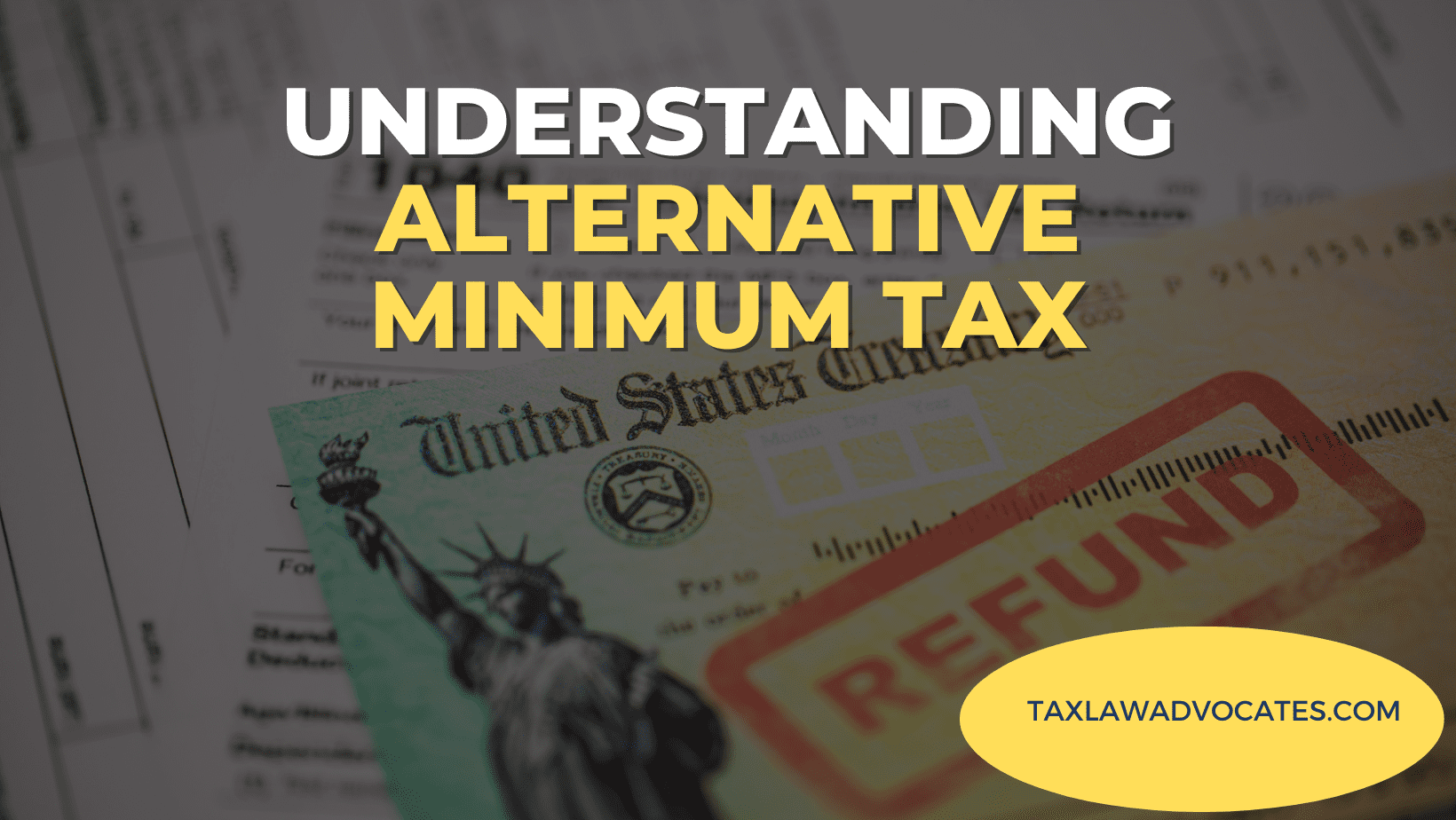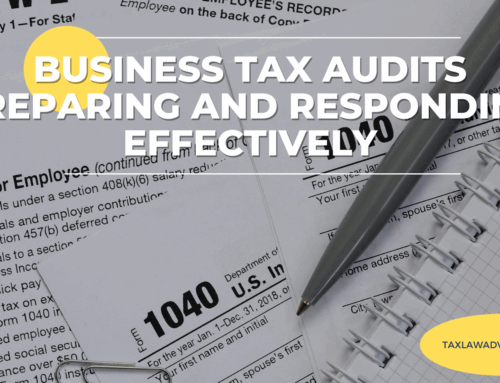Navigating the complexities of the U.S. tax system can be daunting, especially when it comes to understanding the Alternative Minimum Tax (AMT). The AMT is a parallel tax system designed to ensure that high-income taxpayers pay at least a minimum amount of tax, regardless of the number of deductions or credits they claim. This blog will delve into the intricacies of the AMT, who is affected by it, and tips for managing potential AMT liabilities. If you need personalized assistance, don’t hesitate to contact Tax Law Advocates at 855-612-7777 or visit our website.
What is the Alternative Minimum Tax (AMT)?
The AMT was introduced to prevent high-income taxpayers from exploiting numerous tax benefits to significantly reduce or eliminate their tax liabilities. Essentially, the AMT sets a floor on the percentage of taxes that a filer must pay, ensuring that everyone contributes their fair share. Unlike the regular tax system, which allows for a variety of deductions and credits, the AMT requires taxpayers to add back certain tax preference items to their income, resulting in a recalculated taxable income.
How is the AMT Calculated?
Calculating the AMT involves several steps:
- Compute Taxable Income: Start by computing taxable income while eliminating or reducing certain exclusions and deductions.
- Adjust for Preferences: Add back preferential deductions to determine the Alternative Minimum Taxable Income (AMTI).
- Subtract Exemption: Subtract the AMT exemption amount from the AMTI.
- Apply AMT Rates: Multiply the resulting amount by the appropriate AMT tax rates (26% or 28%).
- Subtract AMT Foreign Tax Credit: If applicable, subtract the AMT foreign tax credit.
The final figure, known as the tentative minimum tax, is compared to the regular tax liability. The taxpayer pays the higher of the two amounts.
AMT Exemption Amounts and Phase-Outs
For tax year 2023, the AMT exemption amounts are:
– $81,300 for single filers
– $126,500 for married joint filers
For tax year 2024, the amounts increase to:
– $85,700 for single filers
– $133,300 for married joint filers
However, taxpayers with AMTI above certain thresholds will see their exemptions reduced. For 2023, the phase-out begins at $578,150 for single filers and $1,156,300 for married joint filers. For 2024, the phase-out begins at $609,350 for single filers and $1,218,700 for married joint filers.
Who is Affected by the AMT?
The AMT primarily affects high-income taxpayers who claim substantial deductions. Common factors that trigger the AMT include:
– High state and local taxes
– Large mortgage interest deductions
– Substantial miscellaneous itemized deductions
– Exercising incentive stock options
– Significant income from private activity bonds
To determine if you are subject to the AMT, you must complete IRS Form 6251. This form helps you calculate your AMTI and compare it to the AMT exemption to see if you owe additional tax.
AMT Rates and Liability
There are two AMT rates:
– 26% on AMTI up to $220,700 for all taxpayers ($110,350 for married filing separately) for 2023.
– 28% on AMTI exceeding $220,700 for all taxpayers ($110,350 for married filing separately) for 2023.
For 2024, the threshold for the 28% rate is $232,600 for all taxpayers ($116,300 for married filing separately).
If your tentative minimum tax is higher than your regular tax liability, you must pay the difference as AMT. Essentially, you pay the full amount of the tentative minimum tax if it exceeds your regular tax.
Tips for Managing AMT Liability
- Monitor Tax Preferences: Be aware of the tax preference items that can trigger the AMT. Keeping track of these can help you manage your taxable income more effectively.
- Plan Deductions Strategically: Consider the timing of certain deductions, such as state and local taxes or mortgage interest, to minimize AMT impact.
- Exercise Stock Options Wisely: If you have incentive stock options, plan carefully when to exercise them to avoid large AMT liabilities.
- Consult a Tax Professional: Tax Law Advocates can provide personalized guidance to help you navigate the complexities of the AMT. Contact us at 855-612-7777 or visit taxlawadvocates.com for expert advice.
AMT and Tax Credits
If you are not liable for AMT in the current year but have paid AMT in previous years, you may be eligible for the minimum tax credit. This credit allows you to offset your regular tax liability in subsequent years. To claim this credit, complete Form 8801, Credit for Prior Year Minimum Tax – Individuals, Estates, and Trusts.
AMT and Educational Tax Benefits
Educational expenses can also impact your AMT calculations. While deductions and credits for tuition and fees can reduce your regular tax liability, they might not provide the same benefits under the AMT. It’s crucial to understand how these educational tax benefits interact with AMT rules.
Education Tax Credits
- American Opportunity Tax Credit (AOTC): This credit can reduce your tax bill by up to $2,500 per eligible student. However, you cannot claim the AOTC if you were a nonresident alien for any part of the tax year, unless you elect to be treated as a resident alien for federal tax purposes.
- Lifetime Learning Credit (LLC): This credit provides up to $2,000 per tax return, regardless of the number of students. It’s available for all years of post-secondary education and for courses to acquire or improve job skills.
Student Loan Interest Deduction
You can deduct up to $2,500 of interest paid on qualified student loans. This deduction is an adjustment to income, meaning you can claim it even if you do not itemize deductions on your tax return.
Understanding the Alternative Minimum Tax is crucial for high-income taxpayers who may be affected by it. The AMT ensures that everyone pays a fair share of taxes, but its complexity can be challenging. Proper planning and strategic management of deductions and credits can help mitigate its impact. For personalized assistance, contact Tax Law Advocates at 855-612-7777 or visit taxlawadvocates.com. Our team of experts is here to help you navigate the complexities of the AMT and optimize your tax situation.
Navigating the complexities of the U.S. tax system, particularly the Alternative Minimum Tax (AMT), can be daunting. The AMT is designed to ensure that high-income taxpayers pay their fair share, but understanding its nuances and implications can be challenging. For expert guidance and personalized assistance and to ensure you’re making the most of your tax situation, contact Tax Law Advocates at 855-612-7777 or visit our website. Our team of professionals is dedicated to helping you navigate these complexities and optimize your tax outcomes.






